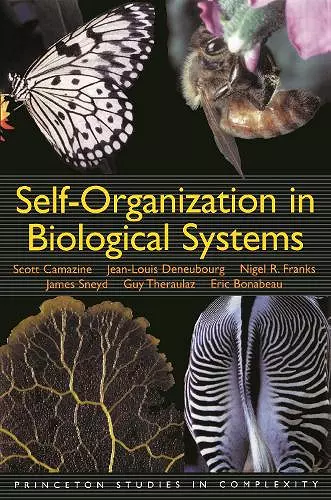Self-Organization in Biological Systems
James Sneyd author Eric Bonabeau author Guy Theraulaz author Scott Camazine author Jean-Louis Deneubourg author Nigel R Franks author
Format:Paperback
Publisher:Princeton University Press
Published:2nd Sep '03
Should be back in stock very soon

The authors' lively yet scholarly account of the rapidly emerging new science of group behavior should captivate anyone who has an inquiring mind and a curiosity about what new directions biology is taking, including undergraduate and graduate students looking for an exciting new way to do biology. This book is a major contribution, not only to biology, but well beyond. -- Robert Jeanne, University of Wisconsin-Madison This ambitious volume has the potential to be a pivotal (even breakthrough) contribution to the biology of complex systems. It aims to facilitate both conceptual understanding and also correct application of the principles of self-organization in a biological context. -- Kern Reeve, Cornell University
A primer on self-organization in biological systems for students and other enthusiasts, this book introduces readers to the basic concepts and tools for studying self-organization and then examines numerous examples of self-organization in the natural world.The synchronized flashing of fireflies at night. The spiraling patterns of an aggregating slime mold. The anastomosing network of army-ant trails. The coordinated movements of a school of fish. Researchers are finding in such patterns--phenomena that have fascinated naturalists for centuries--a fertile new approach to understanding biological systems: the study of self-organization. This book, a primer on self-organization in biological systems for students and other enthusiasts, introduces readers to the basic concepts and tools for studying self-organization and then examines numerous examples of self-organization in the natural world. Self-organization refers to diverse pattern formation processes in the physical and biological world, from sand grains assembling into rippled dunes to cells combining to create highly structured tissues to individual insects working to create sophisticated societies. What these diverse systems hold in common is the proximate means by which they acquire order and structure. In self-organizing systems, pattern at the global level emerges solely from interactions among lower-level components. Remarkably, even very complex structures result from the iteration of surprisingly simple behaviors performed by individuals relying on only local information. This striking conclusion suggests important lines of inquiry: To what degree is environmental rather than individual complexity responsible for group complexity? To what extent have widely differing organisms adopted similar, convergent strategies of pattern formation? How, specifically, has natural selection determined the rules governing interactions within biological systems? Broad in scope, thorough yet accessible, this book is a self-contained introduction to self-organization and complexity in biology--a field of study at the forefront of life sciences research.
One of Choice's Outstanding Academic Titles for 2002 Winner of the 2001 Award for Best Professional/Scholarly Book in Biological Science, Association of American Publishers "We suspect that the ideas associated with self-organization will play an increasingly prominent role in biology for some time to come... Self-Organization in Biological Systems presents a unique opportunity to watch a group of active researchers apply these intriguing concepts to formerly mystifying feats of social organization in animals. We know of no better guide for those who wish to understand how modeling can be used to dissect the mechanisms of self-organized biological systems."--John W. Pepper and Guy Hoelzer, Science "[An] exceptionally well organized and superbly illustrated volume."--Choice "An important contribution to biology, and to complex systems research more generally, and certainly an enthralling subject."--Carl Anderson, Complexity "This is a fascinating and thought-provoking book... The authors provide an excellent introduction to the main ideas underlying the theory of self-organization and also deal with some of the criticisms leveled at this emerging field... An eminently readable and stimulating book."--Jens Krause and Iain Couzin, The Quarterly Review of Biology "This book is an entertaining and well-written introduction to the basics of self-organization... Given the clear prose and interesting examples, this book should have wide appeal."--Diane Lipscomb, Science Books & Film "Considering the complexity of the subject, this account is surprisingly and pleasantly accessible and readable. It is one of the few biology books that will appeal equally to research workers and undergraduates."--Bulletin of the British Ecological Society "Broad in scope, thorough yet accessible, this book is a self-contained introduction to self-organization and complexity in biology--at the forefront of life sciences research."--Zentralblatt MATH
- Winner of AAP/Professional and Scholarly Publishing Awards: Biological Science 2001
- Short-listed for Choice Magazine Outstanding Reference/Academic Book Award 2002
ISBN: 9780691116242
Dimensions: unknown
Weight: 794g
562 pages